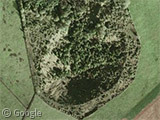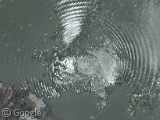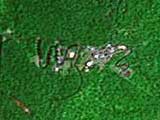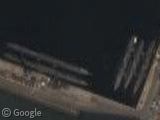Fauld Explosion
Thursday, 27th November 2008 by Alex Turnbull
During WWII, the RAF used the old plaster mine at Fauld, England, as storage for up to 20,000 tons of ammunition. 64 years ago today, on the 27th November 1944, the underground ammunition store blew up. The explosion was to this day, the world's biggest non-nuclear explosion1 (Update: biggest non-nuclear explosion on UK soil).
Nearly 4,000 tons of ordnance exploded, and eye witnesses reported seeing two distinct columns of black smoke rising hundreds of metres from the resulting crater, which is still clearly visible today.
Although at least 70 people died as a result of the explosion, many of the men who were underground at the time actually made it to the surface unscathed. It was later agreed that the most likely cause of the explosion was an airman working on a bomb using a brass chisel - which produced a fatal spark.
Whilst much of the storage facility was annihilated by the explosion, the site itself continued to be used by the RAF for munition storage until 1966, and there are still a considerable amount of unexploded munitions buried below the crater.
The BBC has a story about the Fauld Explosion, Wikipedia has their usual offering, and I found an independent site that has a full history and lots of good photos, including this picture of a soldier loading bombs - which clearly demonstrates just how huge this explosion must have been.
Thanks to Chris Davey.
-
Presumably this doesn't include naturally occuring explosions. ↩︎





Did i not mention this before? Not trying to steal Chris’s thunder – just thought it had been featured already. Anyway, enough about my Alzheimers – fascinating story – i heard a programme on the radio about this a few years ago. Most of the dead werent in the mine but in a factory near by that was destroyed when the explosion broke a dam. I believe the story was covered up until well after the war for morale purposes.
Hmmm, at 4000 tons, the “largest” part isn’t that certain. 😉
PEPCON, Halifax, Heligoland, Texas City, Minor Scale…
I’m afraid that was a nuclear explosion Flümo, so Fauld remains the “world’s biggest non-nuclear explosion”.
Alex: No, that’s the point: Minor Scale was a simulation of a nuclear explosion using conventional explosives.
Oh, BTW: The linked Wikipedia entry just claims “largest non-nuclear on UK soil”. That I accept 😉
Dammit, of course you’re right Flümo. Curse you!
Re: Wikipedia – I read the sentence “the largest non-nuclear explosions in history”, but failed to notice the prefix “one of”. Shoddy work, my apologies!
I shall update the post.
“One search party found a cow standing motionless, twice it’s normal size obviously inflated by air under pressure. The party quickly shot the animal to save further pain, but it failed to fall down – it was obviously already dead, but the position of it’s legs were maintaining it’s upright position.”
Where was youtube when we really needed it!
> biggest non-nuclear explosion on UK soil
How many nuclear explosions were there on UK soil?
@Aran: I think that’s “none”. Certainly all the UK test explosions were done in Nevada.
It seems that comparing explosion sizes is a difficult task, and that none of these “largest” facts stand up to much scrutiny. I mean, how exactly do you measure the size of an explosion? It it noise? height of cloud? size of resultant crater?
I think we’ll have to just stick with “it was a big explosion”. You can’t argue with that.
re: James
The UK’s first Nuclear test shot, Hurricane, was tested on an island near Australia. The first UK thermonuclear test shot, Grapple, was on an atoll in what is now Kiribati. The first twenty or so nuclear tests that the UK did were in the Pacific- they only switched to Nevada after the 1958 agreements that essentially made the British nuclear program an adjunct of the American one.
i fail to see the significance of the brass chisel. These were issued to armourers because they would not cause sparks.
Even the claim that it was the biggest non-nuclear explosion on UK soil is dubious, as Heligoland was under UK administration at the time of the (bigger) “British Bang” on 18 April, 1947.
@ExpatEgghead – apparently the brass chisel was the official RAF explanation….
http://en.wikipedia.org/wiki/RAF_Fauld_Explosion#Cause
I think ExpatEgghead’s quarrel was with the assertion that the chisel caused a spark (which brass chisels are meant to prevent) … and the Wikipedia text says nothing about a spark …